|
|
|
Byrd
I: 1928-1930
Sent from Little America
by J.J. "Teddy" Bayer, engineer on the S.S. CITY OF NEW
YORK .
|
|
Dunedin, N.Z.
Feb. 16, 29
My
dear Miss Philibert:
Your letter
received and glad to hear from you. Thanks a lot for the compliment
and clippings. The folks and friends at home must certainly appreciate
them too. I don't think you know any of the other Washingtonians.
Charlie Lofgren is on the "City of New York". A few sidelights on
the recent trip to the "Barrier" might prove interesting. Our good
friends in New Zealand were wagging their heads when we shoved off
and many said we were slated for a "watery grave". In all fairness
to them, we must admit that our ship looked anything but sea-worthy.
Our cargo was perhaps the most general one ever shipped. It consisted
of everything from toothpicks to (2) aeroplanes.
|
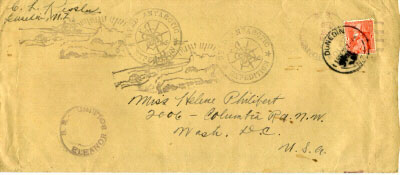
 An
interesting letter ... life in 1929 Antarctica An
interesting letter ... life in 1929 Antarctica
|
Welcome
Home! Aviator's Post 743 of the American Legion welcomes Admiral
Byrd to New York City. Signed Bernt Balchen, chief aviator
on the historic flight over the Pole in November 1928. This cover
was prepared to commemorate the dedication of the Floyd Bennett
Municipal Airport, by Byrd, on June 26, 1930. The cachet on the
reverse of this cover is an imitation Byrd I cancellation, designed
and used by prolific philatelic dealer A. C. Roessler. It is believed
that Roessler intentionally made a slight adjustment to the cachet
(leaving out the lower right meridian line) in order to support
his claim that this was not a forgery.
|
Byrds'
Aviators (L to R) Harold June, Dean Smith, Bernt Balchen
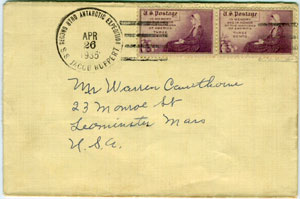 SS
JACOB RUPPERT
SS
JACOB RUPPERT
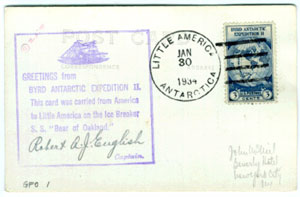
Carried
aboard SS BEAR OF OAKLAND
This
example is from a set of 17 postcards issued for the expedition.
On the reverse are various photos from the prior Byrd
I Expedition. Captain English personally signed a possible
15,000 cards and most likely saw to the cancelation of
many at the "branch"
Little America II post office aboard the BEAR.
|
|
Byrd
II: 1933-1935
Due
to her slower speed, the BEAR OF OAKLAND, under
the command of Lieutenant (J.G.) Robert A. English, U.S.N. left
Boston harbor on September 25th, 1933, nearly two-and-a-half weeks
earlier than the JACOB RUPPERT. While en route to
the Panama Canal a hurricane was encountered, nearly sinking the
ship off Southport, North Carolina. She met a full gale off Diamond
Shoals lightship and was warned by radio that the strongest part
of the storm lay dead ahead. Lt. English tried to make a run for
Southport Harbor but by October 4th the seas were breaking over
her decks and she was taking on vast amounts of water, faster
than the pumps could handle it. It was a terrible night as bucket
lines were formed and the crew, scientists and veterans steadied
themselves on slippery decks and ladders, passing three-gallon
buckets of bilge water to the main deck and lowering empty buckets
to the men below. The sea rose to the level of the boilers . .
. it was serious indeed. After hours of battling, she finally
made it to shore and anchored off the entrance to the harbor.
Due to the extreme punishment she took, it was necessary to return
to Newport News for dry-docking. Repairs were made and she set
out for Antarctica, this time successfully, on November 1, 1933.
|
|
|
The
typical "Delayed" BYRD II cover, signed R E BYRD |
|
|
Byrd
III: 1939-1941
US ANTARCTIC SERVICE EXPEDITION
USS
BEAR
Canceled
at Little America
|
|
|
Tech
Sgt. Zadik Collier Creation
(VERY RARE)
Covering BOTH trips to / from the Antarctic
|
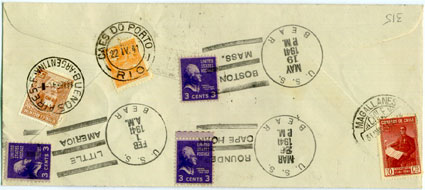 REVERSE
REVERSE |
Reverse
of the Collier cover
|
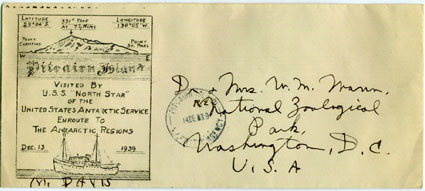
 Cover addressed
by the expedition Ornothologist and sent to the National Zoological
Park in Washington, D.C.
Cover addressed
by the expedition Ornothologist and sent to the National Zoological
Park in Washington, D.C. |
RICHARD
BLACK CREATION
(VERY RARE)
Philatelically, the most significant port-of-call enroute to Antarctica
was made by the USS NORTH STAR at Pitcairn Island.
The resultant Richard Black originated covers, officially sanctioned
by Byrd (who personally approved the commemorative cachet), are
among the most prized philatelic items for the U.S.A.S.E. The vessel
paid a visit to Pitcairn Island on December 13-14, 1939. The Pitcairn
post office was quickly sold out of New Zealand stamps, but through
special arrangements, unstamped covers reached their destinations
as well as those which were franked. The cachet was designed by
Richard Black, leader of East Base, and was applied to mail during
the visit. According to news articles of the day, approximately
790 covers were serviced. Two types of mail from this stop exist
-- mail left at Pitcairn for a stateside destination and mail canceled
at Pitcairn and taken along for the journey south.
|
 |
|
|

